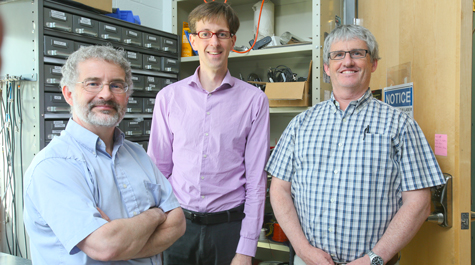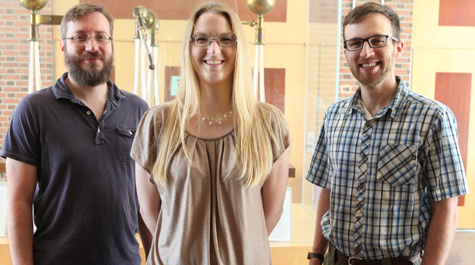In ‘Nature’: drilling down into the secrets of the weak force
A new result from the Q-weak experiment at the Department of Energy’s Thomas Jefferson National Accelerator Facility provides a precision test of the weak force, one of four fundamental forces in nature. This result, published recently in Nature, also constrains possibilities for new particles and forces beyond our present knowledge.
“Precision measurements like this one can act as windows into a world of potential new particles that otherwise might only be observable using extremely high-energy accelerators that are currently beyond the reach of our technical capabilities,” said Roger Carlini, CEBAF Associate Professor in the Department of Physics at William & Mary as well as a Jefferson Lab scientist. Carlini is a co-spokesperson for the Q-weak Collaboration.
The Q-weak Collaboration has always had a large William & Mary contingent. In addition to Carlini, co-authors on the Nature paper include David Armstrong, Chancellor Professor of Physics; Todd Averett, professor of physics; and Wouter Deconinck, assistant professor of physics.
Deconick pointed out that William & Mary has more co-authors on the paper than any other university. The contributors include former postdoctoral fellows Klaus Grimm and Jeong Han Lee as well as a slate of students.
A training ground for scientists
"Beyond its research outcomes, Q-weak was a training ground for many early career scientists," said Anne Kinney, assistant director for the Mathematical and Physical Sciences Directorate at the National Science Foundation. "Twenty-three people earned their Ph.D.s working on this experiment, 17 supported by NSF grants to faculty at five different U.S. universities. Q-weak also provided excellent training opportunities to nearly 50 undergraduate students supported by NSF grants, including several who received NSF Research Experience for Undergraduates awards."
The NSF was a major funder of the William & Mary group. Armstrong was the principal investigator on a $975,000 multi-institution NSF Major Research Instrumentation grant. The grant funded the development and construction of a major part of the experimental apparatus, the so-called "tracking system." He explained that the tracking system was used for the critically-important determination of the "kinematics" — energy, momentum and scattering angle — of the scattered electrons.
Armstrong explained that the largest component of the tracking system was a set of four very large "vertical drift chambers," which were designed, fabricated and tested at William & Mary. These delicate, gas-filled wire chambers were large (8 by 3 feet by 6 inches thick), and each had 558 precisely-positioned hair-thin, gold-plated tungsten wires to use in detecting the electrons that passed through them.
“Each chamber weighed about half a ton and the assembly of four chambers was mounted on a custom assembly that allowed them to be precisely rotated in and out of their measurement positions,” Armstrong said. “The custom readout electronics for these chambers was designed by William & Mary and Jefferson Lab.”
Armstrong said Q-weak provided six William & Mary students with Ph.D. dissertation topics and two more are expected to graduate this calendar year. The list of graduate student co-authors includes Kurtis Bartlett, Juan Carlos Cornejo, James F. Dowd, Valerie M. Gray, Joshua R. Hoskins, John Leckey, Joshua A. Magee and Siyuan Yang.
In addition, Armstrong said that more than a dozen William & Mary undergraduate research students have also made contributions to the experiment over the years. Other undergraduates received an introduction to Q-weak through the REUs Allen mentioned, programs that bring students from other colleges and universities to work on a project for a summer at William & Mary.
Remembering Professor Finn
The late Professor J. Michael Finn also is among the authors on the paper. Finn and Armstrong were involved in the Q-weak experiment since its conception in 2000.
“He was one of the original spokespersons for the experiment, and one of the developers of the concept,” Armstrong said. “ Sadly, he passed away in January 2009, while the experiment was being constructed.”
The objective of the Q-weak investigation is a better understanding of the weak force. It’s one of the four basic forces of nature — the others are gravity, electromagnetism and the strong force, which is the name scientists give to the interaction that holds the nucleus of the atom together.
While the weak force is difficult to observe directly, its influence can be felt in our everyday world. For example, the weak force initiates the chain of reactions that power the sun. It also provides a mechanism for radioactive decays that partially heat the Earth’s core and that also enable doctors to detect disease inside the body without surgery.
Exposing a secret of the weak force
Now, the Q-weak Collaboration has revealed one of the weak force’s secrets: the precise strength of its grip on the proton. They did this by measuring the proton’s weak charge to high precision, which they probed using the high-quality beams available at the JLab’s Continuous Electron Beam Accelerator Facility, a DOE Office of Science User Facility.
"After more than a decade of careful work, Q-weak not only informed the Standard Model, it showed that extreme precision can enable moderate-energy experiments to achieve results on par with the largest accelerators available to science," Kinney said. "Such precision will be important in the hunt for physics beyond the Standard Model, where new particle effects would likely appear as extremely tiny deviations."
To measure the proton’s weak charge, an intense beam of electrons was directed onto a target containing cold liquid hydrogen, and the electrons scattered from this target were detected in a precise, custom-built measuring apparatus.
The key to the Q-weak experiment is that the electrons in the beam were highly polarized – prepared prior to acceleration to be mostly “spinning” in one direction, parallel or anti-parallel to the beam direction. With the direction of polarization rapidly reversed in a controlled manner, the experimenters were able to latch onto the weak interaction’s unique property of parity (akin to mirror symmetry) violation, in order to isolate its tiny effects to high precision: a different scattering rate by about 2 parts in 10 million was measured for the two beam polarization states.
It all agrees with the Standard Model
The value proton’s weak charge was found to excellent agreement with predictions of the Standard Model, which takes into account all known subatomic particles and the forces that act on them. Because the proton’s weak charge is so precisely predicted in this model, the new Q-weak result provides insight into predictions of hitherto unobserved heavy particles.
For example, the Q-weak result has set limits on the possible existence of leptoquarks, which are hypothetical particles that can reverse the identities of two broad classes of very different fundamental particles – turning quarks (the building blocks of nuclear matter) into leptons (electrons and their heavier counterparts) and vice versa.
“It’s complementary information. So, if they find evidence for new physics in the future at the LHC, we can help identify what it might be, from the limits that we’re setting already in this paper,” said Greg Smith, Jefferson Lab scientist and Q-weak project manager.
The Q-weak Collaboration consists of about 100 scientists and more than 20 institutions. The experiment was funded by the United States Department of Energy Office of Science, the National Science Foundation, the Natural Sciences and Engineering Research Council of Canada, and the Canadian Foundation for Innovation, with matching and in-kind contributions from a number of the collaborating institutions.
Jefferson Lab is supported by the Office of Science of the U.S. Department of Energy. The Office of Science is the single largest supporter of basic research in the physical sciences in the United States, and is working to address some of the most pressing challenges of our time. For more information, please visit science.energy.gov.
 Skip to main content
Skip to main content


